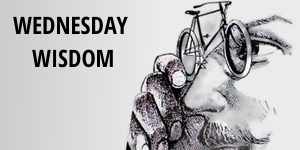Wednesday Wisdom - Tire Selection & Tire Pressure

Tire choice and tire pressure can make a major difference in your riding experience, affecting everything from durability and flat risk to comfort and speed on the bike. Durability and flat protection come from thicker layers and addition of particularly strong materials to the tire to prevent debris from penetrating through the tire and causing a flat. Tire pressure can also come into play here--drastically low pressures can increase the risk of pinch flats (a type of flat where an impact causes the tire to pinch the tube).
Selection and Rolling Resistance
How fast a tire is (in other words, the speed and energy savings of a tire) comes mainly from something called rolling resistance, or how much resistance the tire has against the road. In simple terms, something with a higher rolling resistance means that it takes more energy to keep the tire moving, making it less energy efficient. On the other hand, something with a low rolling resistance is more efficient and requires less energy to roll along. To put the level of energy savings into perspective, choosing a tire that’s light, supple, and has low rolling resistance can save you as much as 15 watts PER TIRE (depending on what tire you’re coming from). Switching to latex tubes (from standard butyl tubes) can save you nearly 2 watts PER WHEEL. So if you switch from Continental Gatorskins (a durable but slower tire) with butyl (standard) tubes to something like the GP5000 with latex tubes, you could save yourself around 23 watts total. In addition, because the tires and tubes are more supple, it’ll make the ride more comfortable--truly achieving the best of both worlds. To see more about rolling resistance of various tires, check out the site Bicycle Rolling Resistance
Tire Pressure
Tire and tube selection are only part of the equation however. To reap the full benefits of those fast tires and tubes that you’re buying, you need to get the pressure right. Your optimal tire pressure depends on a number of factors such as your weight, the tires and tubes you’re riding, the tire width, the condition of the roads you’re riding on, and how fast you’re going. One of the things we’ve learned over time is that optimal tire pressures (for both speed and comfort) are much lower than what we thought was ideal 10 years ago, especially with the industry’s shift to wider tires. The way I think about it is that if we pump our tires up to really high pressures, it makes the tire pretty hard, and then as we’re riding over the imperfect surfaces we ride on, we’re effectively bouncing down the road. Instead, if we lower our tire pressure, we can smooth that out and the tire deforms to the road imperfections allowing for constant road contact and constant power transfer. The easiest way to help zero in on your optimal tire pressure is to use this handy tire pressure calculator tool from Silca at https://silca.cc/pages/sppc-form
Setting the correct pressure can be a big change for most people, but it’s a worthwhile shift. While investigating the pressures recommended for you by the Silca tire pressure calculator, keep in mind that being 10psi under your optimal tire pressure only costs you ~1 watt, while being 10psi over your optimal tire pressure can cost you nearly 9 watts. So this is a case where you’re better off being a little low than high.
It can also be easy to look at this and shrug it off because you’re not trying to be the fastest rider or win races, but these things can make a big difference in your comfort on the bike and the amount of energy and effort you have to exert to stay with your friends on group rides. The other way to look at this is energy savings. The faster/more efficient your tire setup and tire pressure, the less energy you have to exert to go the same speed.
For some more information and reading on these topics check out these resources:


